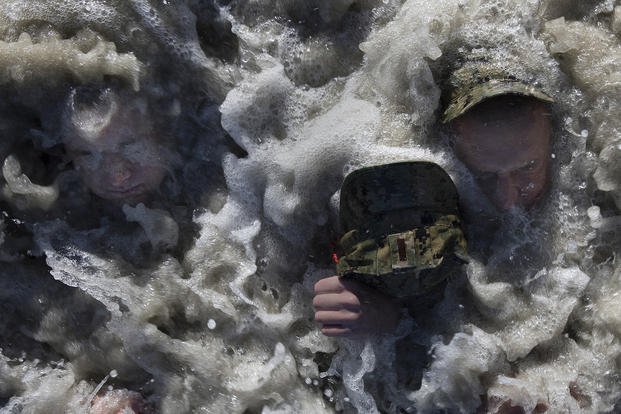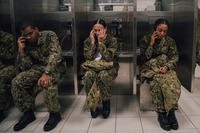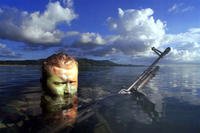[The following is an excerpt from SEAL SURVIVAL GUIDE: A Navy SEAL's Secrets to Surviving Any Disaster, written by former Navy SEAL and preeminent American survivalist Cade Courtley.]
The brain is the strongest muscle in the body. You've heard stories of how combat soldiers have been shot repeatedly but were not aware of it until the fight was over. These stories are true, and the power to do such things comes from the mind and can be tapped into by practicing mental preparation. This practice can allow you to far exceed your physical limitations. Just as you train other muscles, you can train the brain with mental-preparedness exercises -- and you don't need to go to the gym to do it! It's an exercise you can do anywhere. I can't stress enough how important mental preparedness is for surviving and enduring any life-threatening situation that you could encounter. This is how you practice it.
Emergency Conditioning (EC): Make the Unknown Familiar
Using visualization techniques is a good way to practice what we call emergency conditioning (EC). I will highlight this phrase throughout the guide and explain the types of visualizations that are most effective in survival scenarios. It means conditioning the mind in advance of emergencies, thus producing psychological strength in times of crisis. This also is referred to as "battle-proofing" or "battle inoculation" by military personnel. Example: A soldier lying on his cot imagines a nasty firefight with the enemy, including what it will sound like and smell like, the heavy breathing, and the utter exhaustion.
If the brain imagines something in deep and vivid detail, it will become part of a person's "experience files." This visualization exercise actually will fool the brain into believing that you already have experienced this event. You can tap into these files at will by hitting the play button that starts the "movie" of what you already have visualized and planned. It will seem more or less familiar if ever you are confronted with a similar experience. This internal battle-proofing gives you an incredible advantage.
Create a Trigger
One of the last things you need to do as part of creating mental preparedness is develop what I call your trigger. In order to do this, you must dig deep and identify the single most important thing in the world to you and make a mental portrait, so to speak, of this image. This is what you will use to ignite many of the essential qualities needed to survive.
This trigger is the thing that makes you want to live, no matter what comes your way. The most effective trigger will be different for everyone. For some, the trigger will be the image of their child, whom they want to be there for and whom they want to see grow into a man or woman. For others, the trigger image could be elderly parents who need them.
Your trigger image can change as priorities in your life change. When I was going through BUD/S, my trigger was seeing myself walking across the stage at graduation and looking out at family and friends as I was handed my certificate of completion -- that image made me endure. But once I got to a SEAL team and took on the incredible responsibility of leading men into life-threatening situations, my trigger was the image of all my men returning from a mission unharmed. I was not going to attend any of my guys' funerals -- not on my watch -- and that made me pull my trigger and do whatever needed to be done to keep my men alive.
Your trigger could be an aspirational one -- i.e., thinking that nothing is going to rob you of your life before you achieve your goal. It's as powerful as a protective trigger, such as saving the life of a loved one or protecting a member of your team. Both work, as long as you take the time to make this an extremely vivid visualization. Let it burn into the files of your mind. You must be able to say, "I will live and endure anything for this."
This image or visualized goal is now your trigger. You will use this most important memory file as the ultimate motivation to get you through anything life throws at you. But to maintain the effectiveness of your trigger, you should save it for only the direst situations. Life or death ... Pull that trigger!
Situational Awareness
In military-speak, situational awareness is defined as the ability to identify, process and comprehend the critical elements of information about what is happening to the team with regard to a mission. More simply, it's being aware of what is going on around you.
Because I know the importance of situational awareness during battle, I must admit I get annoyed by the vast number of people who go about their lives without paying even the faintest attention to where they are or what's happening around them. It puts them and the general security of society at risk. These are the very people who most often get victimized or end up on the casualty list. The next time you go to a crowded shopping mall or airport, you will be amazed to observe how many people seem to be oblivious to their environment, insulated in their own world. As we will see, airports and malls, in particular, are two places where you should be absolutely vigilant and aware of your surroundings.
Of course, there are environments that require different levels of situational awareness. If you're at home or at a resort, you should fully enjoy the peace and relative security these places afford. As you will learn, these places can be made safe and allow us to relax and enjoy life. On the other hand, airports, the streets of a foreign country or a crowded stadium event, for example, are not the environments in which to take a mental vacation. You owe it to yourself to stay alert. Just like visualization, situational awareness drills can be practiced anywhere. Make it a game you play using the following checklist:
Situational Awareness Checklist
- Try to guess what individuals around you are thinking or doing.
- Look for odd behavior or things that seem out of place.
- Determine where you'd go if you had to seek immediate cover from an explosion or gunshots.
- Find the two closest exits.
- Determine whether someone is following you or taking an unusual interest in you.
Imagine this scenario: You see a guy at a shopping mall wearing a heavy coat, holding a cigarette with two inches of ash on the end of it, and he's not inhaling. He continues to look over his right shoulder at another guy 50 feet away with a similar heavy coat. It is 90 degrees outside. If you practice even the slightest measure of situational awareness, this scene should set off alarms in your head. In terms of honing your situational awareness, you may find it helpful to think of yourself as trying to note variances against the baseline or what is normal.

CADE COURTLEY was born in Columbus, Ohio, and raised in Boulder, Colorado. He spent most of his young adult life in the outdoors, and upon graduation from the University of San Diego, he was immediately commissioned as an officer in the United States Navy and began Navy SEAL training (BUD/S). After several intense tours as a platoon commander that had him operating around the world, Courtley left the SEAL teams to pursue other challenges. He was the host of the Spike TV and Discovery Channel show "Surviving Disaster" and appears as a regular commentator on CNN and Fox News.

From random shootings to deadly wildfires to terrorist attacks, the reality is that modern life is unpredictable and dangerous. In SEAL SURVIVAL GUIDE: A Navy SEAL's Secrets to Surviving Any Disaster (Gallery Books), author Cade Courtley urges readers to learn the SEAL mindset: Be prepared, feel confident, step up, and know exactly how to survive any life-threatening situation.
SEAL SURVIVAL GUIDE on Amazon
SEAL SURVIVAL GUIDE on Barnes and Noble
Text copyright © 2012 by SEAL Survival, LLC. Published by Gallery Books, an imprint of Simon & Schuster, Inc. Printed with permission of Simon & Schuster, Inc.











